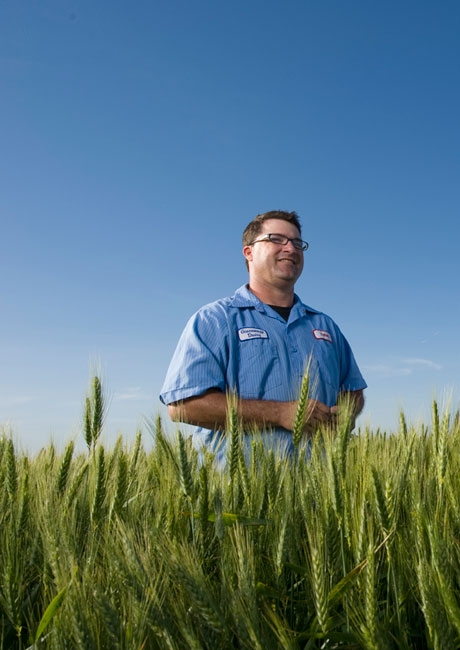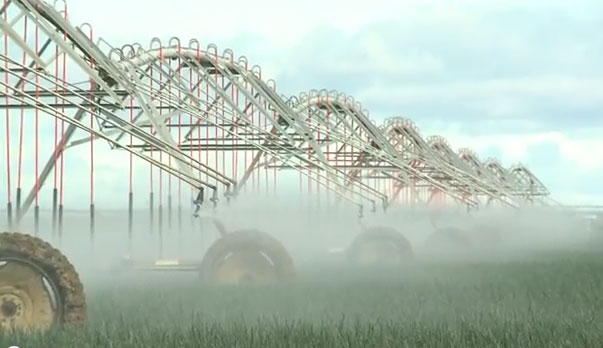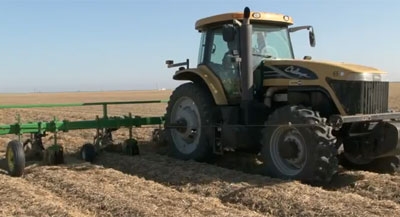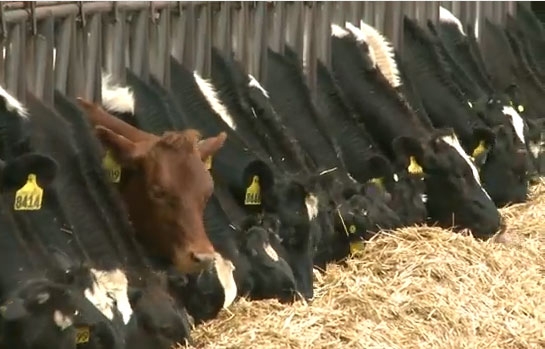Conservation agriculture news
Hanford farmer Dino Giacomazzi receives Leopold Conservation Award
Hanford dairy farmer Dino Giacomazzi, a founding member of UC Conservation Agriculture Systems Innovation (CASI), received the prestigious 2012 Leopold Conservation Award for California in acknowledgement of his exemplary land stewardship and management.
The $10,000 Leopold Conservation Award is named in honor of world-renowned conservationist Aldo Leopold. The award, presented annually in eight states, recognizes farming and ranching families who are actively committed to living a land ethic.
Giacomazzi manages the dairy and forage production operations at Giacomazzi Dairy, established in southeastern Hanford in 1939. He lives on the 300-acre dairy property and oversees milking, animal nutrition and feed production.
In the spring of 2005, Giacomazzi initiated a demonstration evaluation of strip-till corn planting in a 28-acre field as part of an Environmental Quality Incentives Program contract he had received from the USDA Natural Resources Conservation Service.
“Dino virtually guaranteed his ultimate success with conservation agriculture by the sheer intensity of this effort and the comprehensive nature of his attention to detail,” said Jeff Mitchell, UC Cooperative Extension specialist in the Department of Plant Science at UC Davis. Mitchell is the chair of CASI.
Though no one realized it at the time, Giacomazzi was beginning to formulate a conservation agriculture systems approach. The systems approach would later become, as he has said, “completely new forage production systems for the entire dairy industry.”
Following this successful trial, Giacomazzi established all of the dairy’s corn acreage using strip-tillage in 2006. However, rather than take a single approach, he set out a comprehensive array of strip-tillage evaluations that included three different strip-till implements, strip-till corn varieties, and twin-row versus single-row planting configurations.
Later that year, he opened his dairy to the public for a Strip-Till Field Day that attracted more than 150 farmers.
“To this day, CASI considers this field day to be the most successful and impacting extension education event that our workgroup has been involved with during the past decade,” Mitchell said.
Over the course of the strip-till evaluations at his dairy, Giacomazzi also shared his expertise with a number of visitors, including representatives of Sen. Dianne Feinstein’s office in Washington, D.C., and the USDA NRCS Regional Agronomist for the Western U.S.
In his quest for the optimal CT forage corn system, Giacomazzi investigated twin-row planting options and is now one of the state’s primary authorities on twin-row production. The idea is to stagger two lines of plants 7.5 inches apart in 30-inch row spacing, giving plants optimal access to resources – nutrients, light, water, etc. From 2007 to 2009, Giacomazzi rigorously tested this hypothesis in a series of comprehensive on-farm studies.
Since the fall of 2008, Giacomazzi has also been collaborating with scientists from the USDA Agricultural Research Service National Soil Tilth Lab in Ames, Iowa, on a major, large-scale quantification of particulate matter emissions under traditional and conservation tillage at his dairy. He worked with Jerry Hatfield, the research director of the Tilth Lab, and a large group from Utah State University. This group quantified dust emissions using LIDAR, laser beam and dispersion modeling technologies and has found significant reductions in particulate emissions in Giacomazzi’s strip-till system relative to his former standard tillage approach.
Last spring, Giacomazzi began using a twin row Monosem planter on his farm that enables GPS precision guidance and application technologies from Trimble Corporation. This instrumentation allows for precision application of seed and nutrients in the same planting pass. He recently showcased his progress on his CT silage production systems by opening his farm to still another public field day that attracted several farmers and media coverage.
“Dino’s contributions to our collective efforts in CASI have been unparalleled,” Mitchell said. “He has made huge contributions to the development of knowledge and to the expansion of conservation agricultural systems in California’s Central San Joaquin Valley.”
_
Learn more: On Jan. 27, 2012, Giacomazzi presented the keynote address at the public launching of the Conservation Agriculture Systems Innovation Workgroup. A video recording of his address is posted on the CASI website: http://casi.ucanr.edu/Video_library_636/CASI_launch_video_archive/
Plant science professor receives high honor
Fresno State plant science associate professor Anil Shrestha will receive the 2013 Outstanding Reviewer Award from the Weed Science Society of America.
The honor will be presented at the annual meeting, Feb. 4-7 in Baltimore, Maryland. The award recognizes professionals for outstanding work in reviewing scientific papers in the industry.
Shrestha joined Fresno State in 2008 and has taught various undergraduate and graduate plant science classes. He received a master’s degree from Cornell University and a doctorate from Michigan State University in Crop Ecology and Management. His professional experience also includes work as a weed ecologist with the University of California’s Statewide Integrated Pest Management Program.
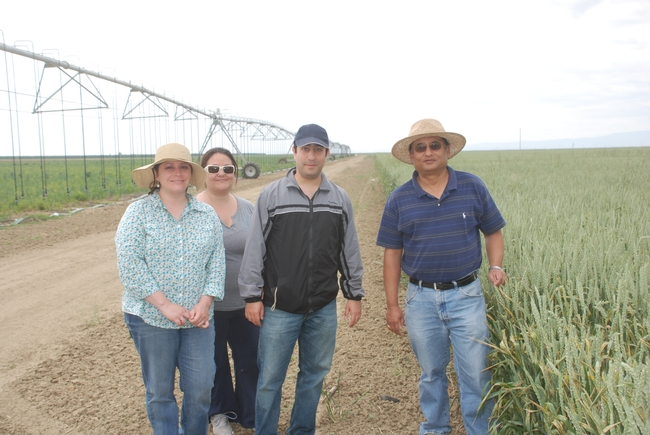
Fresno State professor Anil Shrestha (far right) with students at a research site.
Merging conservation tillage with overhead irrigation systems
"One of the things that we see with overhead systems and the sprinkler packages that we have attached to them is that they are highly efficient," said Dan Munk, UC Cooperative Extension advisor in Fresno County, on the video. "They are highly efficient systems because they apply water uniformly. If we time this properly with proper irrigation scheduling techniques, we can reduce the amount of water applied."
Water, notes Monte Bottens, president of California Ag Solutions, is "the key to everything."
"If the water is not there and the water is not right, forget it," Bottens said.
West side farmer John Diener goes on to explain in the video that, in addition to delivering water uniformly, overhead irrigation, such as center pivots, gives farmers more flexibility with the land.
"All the tillage we did prior to having pivots was done primarily so we could run water from one end of the field to the other and put it on uniformly," Diener said. "With this practice, we have eliminated the need to have such great uniformity on the soil surface and, as such, we can do more non-tillage practices that allow us to store more carbon in the soil."
The University of California dedicates its first center pivot irrigation system at the UC West Side Research and Extension Center on Thursday. The dedication is part of the annual Twilight Conservation Agriculture field day, scheduled for 4 p.m. Sept. 13. Farmers and other members of the public are invited to the free event to see the system in operation and learn how overhead irrigation can be combined with no-till or minimum-till farming methods to create a more sustainable, profitable and environmentally sound agriculture industry. The field day includes a free barbecue dinner. For more information, see the field day announcement. To register, go to http://ucanr.edu/TwilightRegistration.
Video 5 describes minimum tillage, a sub category of conservation agriculture
Farming in California has traditionally involved a series of preplant tillage operations, including disking, subsoiling, land planing, bed formation and dry mulching. The fifth installment of the Conservation Agriculture Systems Innovation documentary details a viable alternative - a sub category of conservation agriculture known as "minimum tillage." The video is available today on the CASI website. (It is also posted below.)
Minimum tillage refers to systems that reduce tillage passes for a given crop by at least 40 percent relative to what was conventionally done in the year 2000.
"Tillage is the one situation the grower still can deal with,” Alan Wilcox, president of Wilcox Agri-Products, says in the video. “He can’t really affect the fertilizer price, the seed price, the herbicide price or the revenue he gets from his crop. But he still has a tremendous amount of control over how he tills his fields.”
Reducing the cost of production has motivated many farmers featured in the video to look into minimum tillage. For example, Mendota farmer Gary Martin said his operation has been able to reduce fuel consumption by a third with minimum tillage.
"Over the years, we've saved a tremendous amount of money just in fuel, but it also cut down in labor," Martin said.
Minimum tillage research findings provide further support to growers who may be interested in giving the new systems a try.
"What gets you there is a little confidence from a completely autonomous group like UC Davis, that are not persuaded by any other factors other than results and economics that make you feel comfortable about the size of your first endeavor," Wilcox said.
More information about minimum tillage will be available the annual Twilight Conservation Agriculture field day, to be held at 4 p.m. Sept. 13 at the UC West Side Research and Extension Center, 17353 W. Oakland Ave. in Five Points. To register, go to: http://ucanr.edu/TwilightRegistration. For more information about the field day, see the field day announcement.
All videos in the series are available on the documentary table of contents.
Dairy feed's amenability to conservation ag is focus of latest documentary episode
Dairy feed production is particularly amenable to conservation agricultural practices, according to four dairy operators featured in Part 4 of the Conservation Agriculture documentary series, released today on the Conservation Agriculture Systems Innovation website. (The video is also posted below.) Planting equipment for production of winter small grains like wheat and triticale and summer corn and sorghum are readily available and production processes have been widely used.
In dairy feed production, conservation agriculture stands to cut tillage costs by $70 per acre, and reduce fuel use by 50 percent and dust emission by 60 percent.
“We’re producing more crops with less input,” says Hanford dairy farmer Dino Giacomazzi in the video. “That’s a win-win.”
Giacomazzi said one of the most important things he has learned in converting from conventional farming to conservation agriculture is that it’s a whole new system and requires a whole new way to think about farming.
Farmers willing to share their experiences with conservation agricultural systems will be part of the annual Twilight Conservation Agriculture field day, to be held at 4 p.m. Sept. 13 at the UC West Side Research and Extension Center, 17353 W. Oakland Ave. in Five Points. To register, go to: http://ucanr.edu/TwilightRegistration. For more information about the field day, see the field day announcement.
View the video here:
Earlier episodes of the Conservation Agriculture Systems Innovation documentary series are available on the table of contents.

